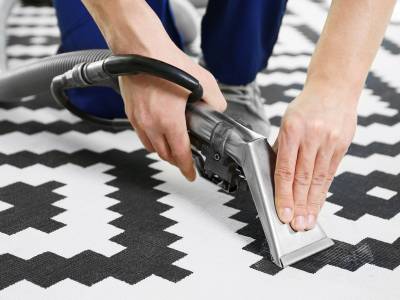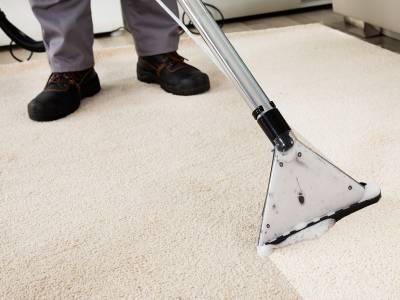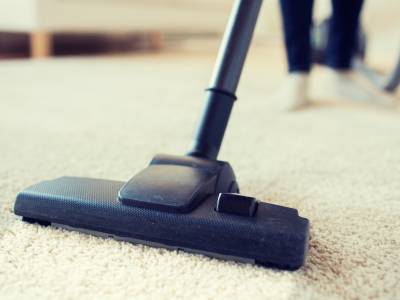Understanding the type of rug that you own is critical so that you know which company offers the safest cleaning method for your rug. Proper identification is the key to protect the investment that you’ve made in a rug. Below are the basics of area rug identification. Start by inspecting both sides of your rug. The top side of the rug will reveal the type of fiber your rug was constructed with and the underside will reveal how the rug was made.
Woven Rugs
Created by hand or by machine knotting fibers around warp yarns.
Tufted Rugs
Created by individual bundles of fibers are “tufted” through a primary backing, covered with latex to hold them in place and then (usually) covered with a cloth backing. If your rug has smooth or multicolored cloth backing, it is tufted, and if the pattern on the back matches the pattern on the front, then it is woven.
Why this matters: Tufted rugs are generally safer to clean using an extraction process (cold water for wool, hot for synthetic) since the latex backing will break down over time anyway, and this deterioration may be accelerated with full-immersion cleaning processes. If the rug has extensive urine damage, immersion washing may be necessary to remove it, but the client should be informed beforehand that latex deterioration may occur, and in some cases, the rug may need to be re-backed with new latex and a fresh canvas cover. This service would be in addition to your normal cleaning charges.
Machine-Woven or Hand-Knotted Rugs
Why this matters: Determining the difference between machine-woven and hand-knotted rugs is the first step in a larger identification process that can save you thousands of dollars in rug replacement due to shrinkage, bleeding and other issues.
While there are some expensive exceptions, machine-woven rugs will generally present fewer cleaning challenges because the dyes are normally more stable and there is usually less shrinkage. Many hand-knotted rugs can be extremely problematic, such as modern Iranian Tabriz, which are known for their propensity to bleed color.
Fiber types
This is a fairly easy test for most IICRC Certified carpet cleaners, so be careful to select trained professionals to care for your rugs.
Synthetics (burn to a hard bead): Olefin and acrylic are the most common synthetic fibers; olefin because it is cheap, acrylic because it was designed as a synthetic substitute for wool.
Nylon has gotten more prevalent in the last few years, even among machine-woven goods, and there are quite a few “hand-carved,” tufted nylon rugs with different colors pieced together to create a scene or pattern. These are then sculpted along the edges of the colors to enhance the effect. Nylon rugs of this nature are often seamed together on the back and can present challenges in cases of severe urine contamination, for instance, due to the possibility of seam deterioration.
Wool, prized for its durability and natural stain resistance, is the most common natural fiber. In some parts of the world, like Afghanistan and Pakistan, wool is used as the foundation fiber as well and care must be used in cleaning these rugs since they are prone to shrinkage or curling. A well-made wool rug can last generations with proper care and regular cleaning.
Cotton is used as a foundation fiber in most hand-woven or knotted rugs, but sometimes the face fiber is comprised of it as well, especially in Flatwoven kilims and Dhurries. It is absorbent and does not resist stains well when used as a face fiber.
Viscose (rayon) could be considered the bane of rug cleaners. Often called artificial silk. Viscose wears quickly, bleeds easily and weakens when wet. It is made from regenerated wood pulp, so it is prone to cellulosic browning in the lighter colors especially. It has come to be used frequently as an accent fiber for designs in wool rugs, though, since it is cheaper than silk — often showing up even in “high-end,” expensive designer rugs.
Silk is found in higher-end, usually hand-knotted, rugs. It maintains its fiber strength even when wet, is resistant to mold and mildew and is an extremely fine, lustrous fiber. Silk is more delicate than wool and wears more easily through abrasion. It is less suitable for use on a floor, particularly in high-traffic areas.
Jute, Sisal, Coir and other natural fibers made from various grasses and fruit husks have become increasingly popular, particularly on the low end of the rug market, but some high-end rugs are made of these fibers, too. Browning and shrinkage can be primary concerns, especially on the flatwoven variety, and heavily-stained rugs made of these fibers can be difficult to completely restore. I have recently seen several knotted-pile sisal rugs dyed with muted to vibrant colors, however, instead of the normal “natural” brown or tan look.
Why this matters: Knowing the fibers with which you are working (both face fibers and foundation fibers) is especially important in rug washing in order to prevent bleeding and shrinkage of the rug and to knowing the best cleaning products and method to produce optimum results.
Afghani rugs woven with wool face fibers on wool foundation yarns may shrink or buckle if immersion washed. A low-moisture process may be best in some cases for these, or if the soil level requires immersion washing, then blocking immediately after the wash during the drying process.
Hand-woven area rugs are works of art, many hours of labor and intricate knowledge was passed down through generations of weavers in each design and construction. They are expensive and cherished works of art passed down through generations of families. Take care of them and they can last a lifetime.









